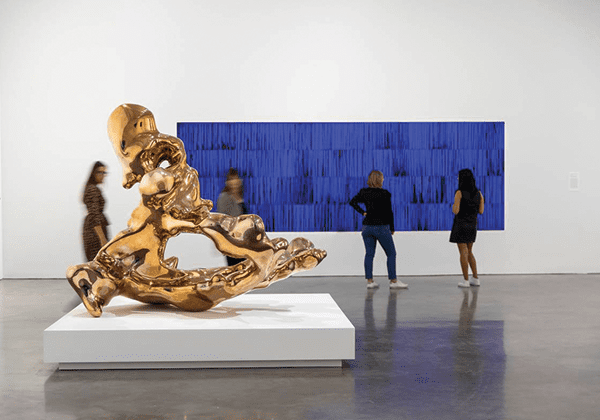A major survey exhibition by artist Lindy Lee recently showed at the Museum of Contemporary Art. Informed by Zen Buddhist philosophies of Master Dōgen, she represents existential mediations of the self and one’s place in the universe. Lee explores a sustained motif of celestial reverence in Moon in a Dew Drop, uniting juxtaposing notions of worldly and metaphysical infinity and finiteness. As a Chinese-Australian artist, Lee’s work is centred on a personal interrogation of self, articulating her sense of cultural identity and personal displacement. However, Lee extends this discourse beyond individual experience and connects her art to a larger understanding of an inextricably intertwined cosmos. As an appreciator of Lee’s most recent exhibition, I will review her installation pieces and a meditation on the personal journey her work prompts in audience members.
Greeted by her piece Seeds of a New Moon, viewers are immediately introduced to the crux of Lee’s exhibition, featuring an elaborate circular design of polished, flung bronze. Epitomising the rich symbolism of Lee’s work, the materials of this piece demand critical appreciation and reveal the direct influence of Dao and Zen Buddhist ideas, encouraging an intuitive and deeply personal recognition of the interconnectedness of humanity and nature. In previous interviews with representatives of the Museum of Contemporary Art, Lee explains that her propinquity to bronze is entirely militant, associating her protective gear with the thick armour of a “great warrior” and the act of flinging bronze itself as mimicking a dangerous battle. Each movement is imbued with purpose and intention, as Zen values dictate, and the finished work reflects every external and internal influence of that moment as it flows through her. A creation unlike any other whose existence is threaded within all other lives – Lee the artist, us the audience, the liquid bronze which formed that shape. This art style is repeated in Strange Condensations and Buddhas and Matriarchs, each illuminated in sections by downlights, emphasising the reflective surfaces. Acting as a fragmented mirror, these regal creations provoke a subconscious introspection, almost preparing us for the spiritual journey ahead.
Central to Lee’s exhibition is the large-scale, polished bronze sculptures and installations, including Open as the Sky and Exploding Suns. Her use of abstract contours exemplifies the mutability of the ‘dew drop’ and her use of bronze encompasses the central Buddhist principles of adaptability as the elemental medium is able to move beyond a single artwork style. Effectively, Lee captures the dewdrop’s organic and constant movement to immortalise it for audiences. The sheer scale of these pieces is intimidatingly engrossing; I found myself drowning in their reflective depths. The sculptures instigate a realisation of an interconnected universe, inspiring audiences to deliberate how many people had viewed this same artwork. My mind was soon occupied by thoughts of others’ personal experiences and interpretations; how had this piece impacted their lives and manifested in their journey of self? Solidifying an understanding of our limitless universe, Lee highlights the delicate bounds of individuals. I found myself appreciating the essence of Lee’s work, and by consequence the Buddhist philosophies which informed it. It is the nature of dewdrops to evaporate; no moment can be a recreation of another, everything is alive, constantly changing and flowing freely.
The immersive Moonlight Deities installation is a visually stunning and profound inclusion to Lee’s exhibition. Encapsulating the ‘moon’ in the dewdrop, sheets of reinforced paper hang from the ceiling, full of variously sized, burnt holes. Carefully illuminated, the room allows these circular patterns to cast intricate shadows on the walls and floor and the moving audiences, leaving no surface uncovered. The piece represents all threads of life intertwining, creating the fabric of the universe, continually changing and shifting as the shadows lift off the walls and onto the skin. The large room allows this symbolism to be literally personified in the multitude of viewers that gaze upon the installation at one time. Under Lee’s artistic guidance, the piece inspired me to understand how every moment is influenced by surrounding moments in an intricate, living and mercurial astronomic web.
The final large-scale piece of Lee’s exhibition is Listening to the Moon, a suspended sphere of polished stainless steel. It radiates a warm glow from the LED light placed in its centre, projecting through the small holes that litter the entire circular surface. Symbolising the moon, the piece is maybe the smallest of her sculptures, subverting natural metrics of the ‘moon’ and ‘dewdrops’. These separate installations also bring the astronomic to the earthly. Personifying Sōtō Zen Buddhist imageries of an infinite and finite universe, Lee draws our attention to the mutuality between corporeality and transcendence. These pieces prompted me to think about spaces of belonging and un-belonging, the subjectivity of my individual life experiences, the communities I felt a part of, and others where I felt my presence left a greater absence.These works evoke a spiritual ecstasy, bringing the vast expanses of our cosmos to the forefront of the conscience, where our place is narrowed, seeming almost inconsequential. We are reminded that each thing is living and significant, entirely unique to a specific moment that can never be recreated, continuously shifting and evolving. Lee’s exhibition represents an intricate cosmic tapestry within which all things are tied to one another.





